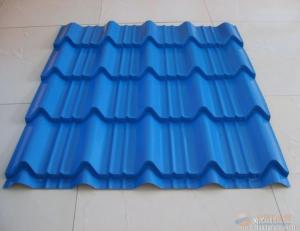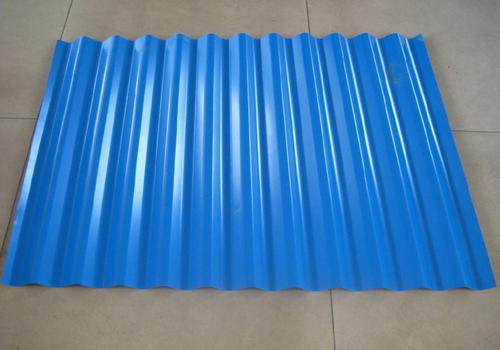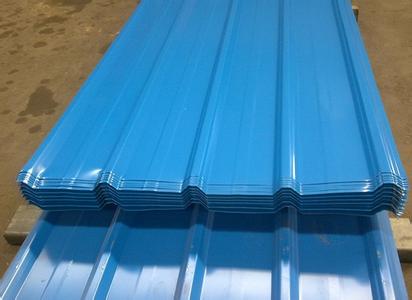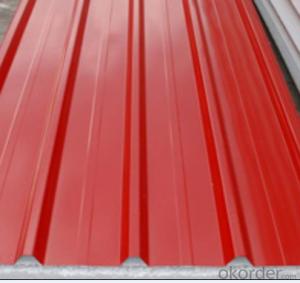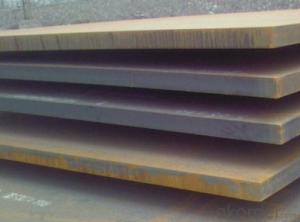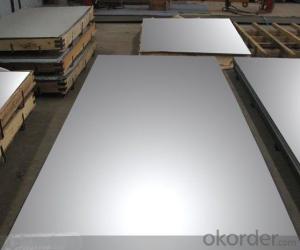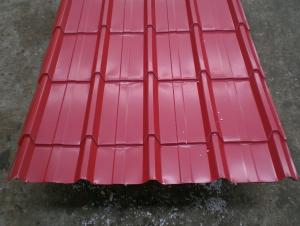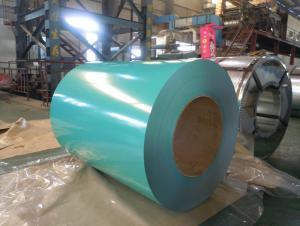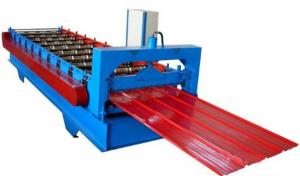Pre-Painted Galvanized / Aluzinc Corrugated Steel Sheet Royal Blue
- Loading Port:
- Tianjin
- Payment Terms:
- TT or LC
- Min Order Qty:
- 50 m.t.
- Supply Capability:
- 10000 m.t./month
OKorder Service Pledge
OKorder Financial Service
You Might Also Like
1. Pre-Painted Galvanized/Aluzinc Steel Coil Description:
With GI as base material, after pretreatment (degrease and chemical treatment ) and liquid dope with several layers of color, then after firing and cooling, finally the plate steel is called pre-painted galvanized (aluzinc) steel.
Pre-painted galvanized steel is good capable of decoration, molding, corrosion resistance.
It generally displays superior workability, durability and weather resistance.
2.Main Features of the Pre-Painted Galvanized/Aluzinc Steel Coil:
• Excellent process capability
• Smooth and flat surface
• Workability, durability
• Excellent heat resistance performance
• High strength
• Good formability
• Good visual effect
3.Pre-Painted Galvanized/Aluzinc Steel Coil Images
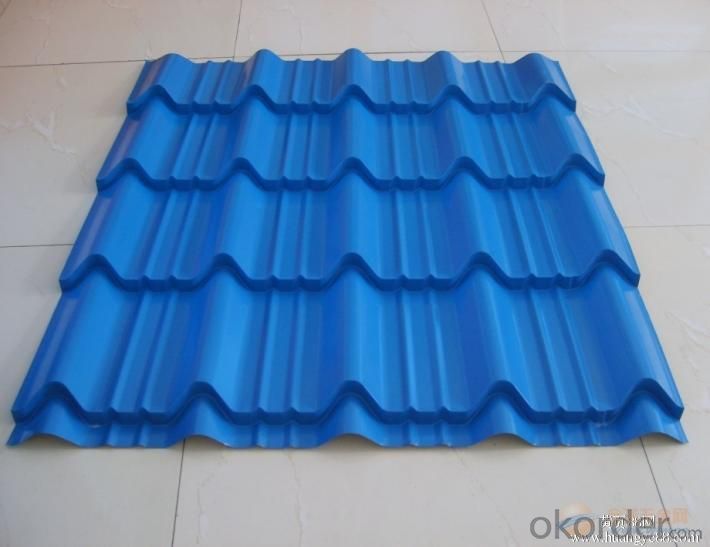
4.Pre-Painted Galvanized/Aluzinc Steel Coil Specification
| Standard | AISI, ASTM, BS, DIN, GB, JIS |
| Grade | DX51D, DX52D |
| Thickness | 0.17-2.0mm |
| Model Number | coil |
| Type | Steel Coil |
| Technique | Cold Rolled |
| Surface Treatment | Coated |
| Application | Roofing |
| Special Use | High-strength Steel Plate |
| Width | 20-1250mm |
| Length | customized |
| Commoidty | pre-painted galvanized steel coil |
| Thickness | 0.13-2.0mm |
| Width | 20-1250mm |
| Zinc Coating | 40-180g/m2 |
| Printing Thickness | top side: 20+/-5 microns, back side: 5-7 microns |
| Color | All RAL color |
| Surface Treatment | color coated |
| Coil Weight | 4-7 tons |
| Coil ID | 508/610mm |
| Packaging | standard seaworthy packing |
5.FAQ of Pre-Painted Galvanized/Aluzinc Steel Coil
1) What’s the application of this product?
Roof, roof structure, surface sheet of balcony, frame of window, etc.
2) What’s the brand of the paint?
We use the best brand of all of the word—AKZO.
3) How about your company?
A world class manufacturer & supplier of castings forging in carbon steel and alloy steel,is one of the large-scale professional investment casting production bases in China,consisting of both casting foundry forging and machining factory.
Annually more than 8000 tons Precision casting and forging parts are exported to markets in Europe,America and Japan.
OEM casting and forging service available according to customer’s requirements.
4) How to guarantee the quality of the products?
We have established the international advanced quality management system,every link from raw material to final product we have strict quality test;We resolutely put an end to unqualified products flowing into the market. At the same time, we will provide necessary follow-up service assurance.
5) How long can we receive the product after purchase?
Usually within thirty working days after receiving buyer’s advance payment or LC.
We will arrange the factory manufacturing as soon as possible. The cargo readiness usually takes 15-25 days, but the shipment will depend on the vessel situation.
- Q: How do steel sheets handle expansion and contraction?
- Steel sheets handle expansion and contraction by allowing enough flexibility to accommodate changes in temperature. This is achieved through the inherent ductility and elasticity of steel, which enables it to expand and contract without significant deformation or damage. Additionally, steel sheets may be designed with specific expansion joints or gaps to further accommodate thermal changes and prevent buckling or warping.
- Q: What is the price range of steel sheets?
- The cost of steel sheets can differ based on various factors, including the steel's type and grade, the sheet's thickness and size, and the prevailing market conditions. Typically, steel sheets can be priced between $0.60 and $1.50 per pound. Nevertheless, it is crucial to note that these figures are only approximate and subject to frequent modifications due to fluctuations in the steel market and other economic elements. To obtain the most precise and current pricing details for steel sheets, it is recommended to consult local suppliers or utilize online platforms.
- Q: Can steel sheets be used in acidic environments?
- Yes, steel sheets can be used in acidic environments but it is important to choose the appropriate type of steel and take certain precautions. Stainless steel, particularly grades with high levels of chromium and nickel, is highly resistant to corrosion and can withstand acidic environments. These types of steel sheets form a passive protective layer on their surface when exposed to oxygen, which prevents further corrosion. However, not all types of steel are suitable for acidic environments. Carbon steel, for example, is prone to corrosion in acidic conditions and would not be recommended for such applications. Additionally, the concentration and temperature of the acid can also affect the performance of steel sheets. To ensure the best performance in acidic environments, it is advisable to consult with steel suppliers or corrosion engineers who can recommend the most appropriate type of steel for specific conditions. It is also important to regularly monitor and maintain the steel sheets to prevent any potential damage or corrosion.
- Q: How do steel sheets perform in high-pressure applications?
- Steel sheets perform well in high-pressure applications due to their high strength and rigidity. They can withstand the force exerted by the pressure and maintain their shape and integrity without deformation or failure. Additionally, steel sheets have good resistance to corrosion, making them suitable for various high-pressure environments.
- Q: Can steel sheets be galvanized or coated with protective layers?
- Yes, it is possible to galvanize or coat steel sheets with protective layers. Galvanization is the process of applying a zinc coating to steel to prevent rusting. This can be done through hot-dip galvanization, where the steel is immersed in molten zinc, or through electroplating, which uses an electrolytic process to apply the zinc coating. Aside from galvanization, steel sheets can also be coated with various protective layers. These coatings may include paint, epoxy, powder coatings, or specialized coatings designed to enhance resistance to corrosion, chemicals, or abrasion. These protective coatings not only enhance the appearance of the steel but also act as a barrier against environmental factors that could potentially damage it. The choice between galvanization and coating depends on the specific application and desired level of protection. Galvanization is commonly used in outdoor applications where steel is exposed to moisture, such as in construction, automotive, and infrastructure industries, due to its excellent corrosion resistance. Coatings, on the other hand, offer a wide range of protective properties and can be suitable for various applications, including indoor environments or where specific chemical resistance is necessary. Ultimately, both galvanization and coating with protective layers are effective methods to increase the durability and lifespan of steel sheets. The selection of the appropriate method depends on factors such as the intended use, environmental conditions, and budget.
- Q: Are steel sheets resistant to UV rays?
- No, steel sheets are not inherently resistant to UV rays. Steel can be vulnerable to UV damage, which can cause it to fade, discolor, or even corrode over time. However, the extent of the damage will depend on various factors such as the type of steel, the thickness of the sheet, the specific UV exposure, and the presence of protective coatings. To enhance the UV resistance of steel sheets, manufacturers often apply coatings such as paint, powder coatings, or galvanized finishes that can provide some level of protection against UV rays. It is important to consult with steel suppliers or manufacturers to determine the specific UV resistance capabilities of the steel sheets being used and to consider additional protective measures if necessary.
- Q: What is the average lifespan of a painted steel sheet?
- The average lifespan of a painted steel sheet can vary depending on various factors such as the quality of the paint, the environment it is exposed to, and the maintenance it receives. However, on average, a well-maintained painted steel sheet can last anywhere from 20 to 50 years. It is important to note that regular inspections, cleaning, and touch-up painting can help prolong the lifespan of a painted steel sheet. Additionally, factors such as exposure to harsh weather conditions, extreme temperatures, or corrosive environments can significantly impact the longevity of the paint and the sheet itself.
- Q: Can steel sheets withstand extreme weather conditions?
- Indeed, steel sheets are engineered to endure even the harshest weather conditions. Renowned for its robustness and durability, steel proves to be an optimal substance for withstanding the unforgiving forces of nature, including fierce winds, torrential rain, heavy snowfall, and extreme temperatures. Frequently employed in construction, roofing, and outdoor applications, steel sheets are constantly exposed to diverse weather phenomena. Moreover, these sheets can be covered with protective coatings like galvanized or painted finishes, further fortifying their resistance against corrosion and weathering. Ultimately, steel sheets exhibit remarkable reliability, enduring severe weather conditions with minimal harm or deterioration.
- Q: Is the steel plate 1.5 meters wide and 2 meters wide at the same price? .
- The price of the steel plate is calculated by ton. There are many ways to calculate the price. The whole plate is a kind of price. If you need a specific size, if the cutting angle can not be used, it will be calculated accordingly.
- Q: Are steel sheets resistant to UV rays?
- Steel sheets do not possess inherent resistance to UV rays, contrary to belief. UV damage can indeed affect steel, leading to fading, discoloration, or even corrosion with the passage of time. However, the degree of harm incurred is contingent upon several factors, including the steel type, sheet thickness, UV exposure specifics, and presence of protective coatings. In order to bolster the UV resistance of steel sheets, manufacturers commonly administer coatings like paint, powder coatings, or galvanized finishes, which offer some level of defense against UV rays. It is vital to consult steel suppliers or manufacturers to ascertain the precise UV resistance capabilities of the steel sheets in use and consider supplementary protective measures if deemed necessary.
Send your message to us
Pre-Painted Galvanized / Aluzinc Corrugated Steel Sheet Royal Blue
- Loading Port:
- Tianjin
- Payment Terms:
- TT or LC
- Min Order Qty:
- 50 m.t.
- Supply Capability:
- 10000 m.t./month
OKorder Service Pledge
OKorder Financial Service
Similar products
Hot products
Hot Searches
Related keywords

